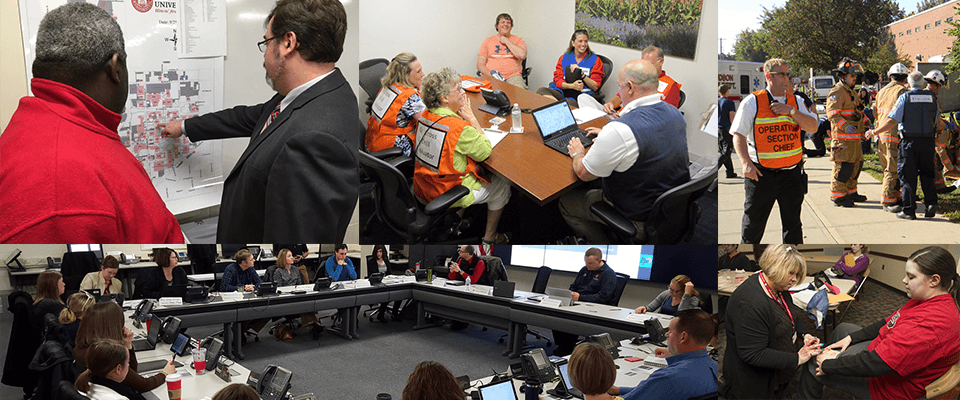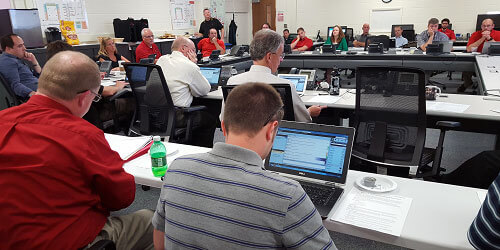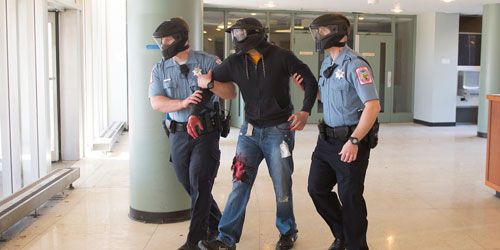Drills and Exercises

Emergency drills and exercises provide the most effective means of learning skills related to emergency preparedness and response. Drills and exercise are hands-on activities that build muscle memory and allow participants to actively engage in learning. Drills and exercises that consistently receive the best feedback are those that had the most planning associated with them. As a result, these are somewhat rare events and we aim to have the most impact with each offering.
Drills
Drills are the next step after training. During training, our emergency team members learn a skill. During drills, they get to practice that skill.
Examples of Campus Emergency Drills:
- IT Disaster Recovery drill: In 2013, staff from campus IT departments assembled to respond to a simulated total loss of power in the University's primary data center. Staff collaborated real-time to discuss appropriate actions, communications tactics and continuity efforts.
- GIS/Mapping drill: In 2016, GIS and Mapping staff were provided a fictitious scenario with many damaged buildings and obstructed roads. The team generated visual maps illustrating the scope of damage, closed roads, shelter areas, media centers, etc.
- Run-Hide-Fight drills: From 2016 through present, Lab School employees (and more recently any interested campus constituent) have been provided the opportunity to experience active shooter scenarios in a controlled environment by practicing Run, Hide and Fight techniques. In the Run scenario, participants run out of their classrooms to areas of safety; in the Hide scenario, participants barricade rooms using furniture; in the Fight scenario, participants use Nerf balls to simulate readily-available items to fend off an attacker.
- Damage Assessment Team drill: In 2016 and 2017, team members conducted pre-emergency assessments on University buildings. Assessments included identifying construction material, surrounding soil composition, date of construction, occupancy, etc. These assessments, while focused on before the emergency, closely resemble steps the team will take after an emergency occurs.
Exercises
Exercises are the most immersive type of training and therefore require the longest preparation time. Two common type of Exercise are:
- Table-top Exercise (TTX): A TTX takes place in a conference room setting and involves a realistic, scripted scenario. Facilitators provide background on events and actions that have taken place up to the time that participants have gathered. Facilitators then prompt participant discussion by asking a series of questions. These carefully-worded questions are specifically designed to be thought-provoking and often generate stressful dialogue. After a series of escalations and further dialogue, the TTX is concluded with a brief recap of the scenario and lessons learned.
- Full-Scale Exercise (FSE): A FSE is a hands-on, realistic scenario with multiple response elements. There is typically a mix of public safety agencies, University response teams and teams/departments involved. FSEs are rare given their complexity, but offer the best opportunity to develop muscle memory. Years later, participants are able to recall specific memories of their involvement and can readily apply those lessons to real-life situations.
Examples of Exercises on Campus
-

CyberSecurity TTX
The IT Cyber Emergency Response Team and the University's Incident Management Team conducted a TTX that simulated an intentional breach of IT systems and a subsequent release of protected data. This exercise presented a plausible scenario along with realistic what-if scenarios that participants worked through. -

Active Shooter FSE
Illinois State University conducted a full-scale exercise with over 300 participants at Atkin-Colby residence halls. State Police SWAT team members served as the "bad guys" and offered an opportunity for public safety responders, University responders, students, faculty and staff a unique opportunity to manage the response to a tragedy.
Please contact Emergency Management if you are interested in conducting a drill or exercise and we will be happy to discuss with you.